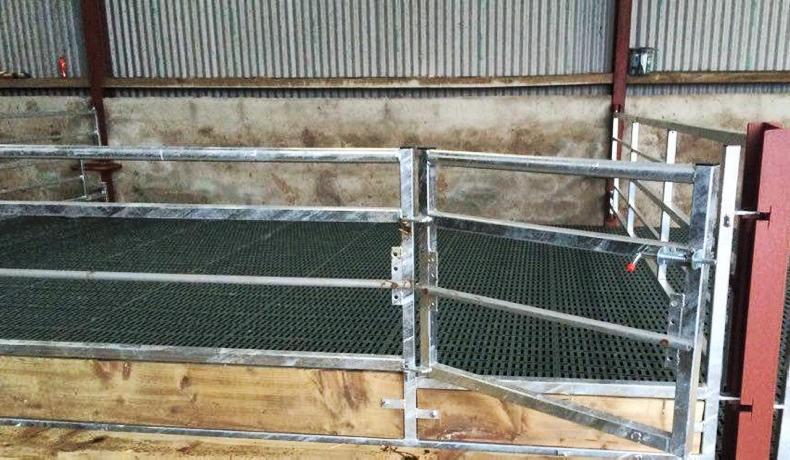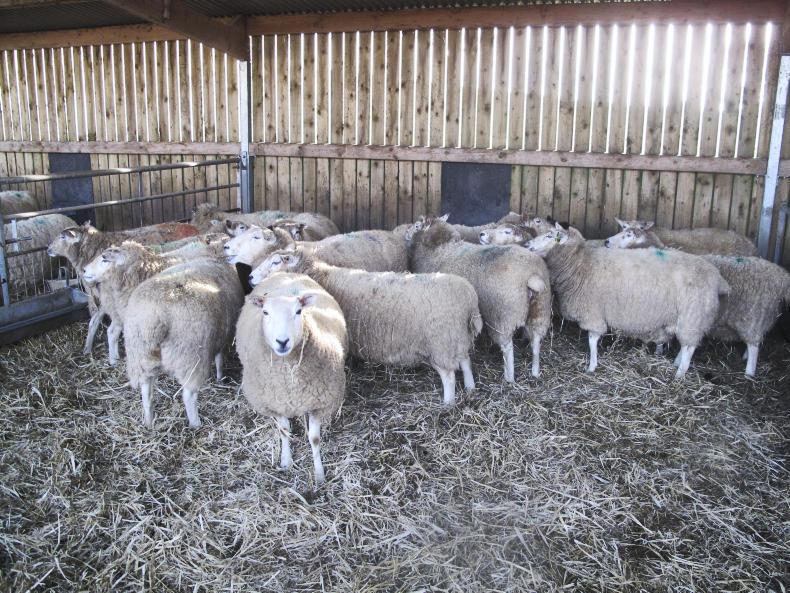Straw supplies are tight again this year. While demand and price has eased in recent weeks, a higher cost is also proving to be a barrier to farmers purchasing similar quantities to previous years.
While some alternative plans can be put in place to overcome tight supplies for flocks housed in mid and late pregnancy, when it comes to lambing, skimping on straw is a false economy when you consider the knock-on effects of disease getting established. For this reason, ensuring there are sufficient supplies available for lambing should be the starting point in calculations.
Teagasc advises that for a typical flock four to five 4 x 4 round bales will be required per 100 ewes for bedding lambing pens. This may need to be increased where dealing with high-prolificacy flocks.
The next step is counting how many bales are available and calculating how long this will suffice to bed ewes or if alternative plans need to be made. Nitrates regulations storage figures state lowland ewes will typically require 7kg straw bedding per week to absorb all urine while hill ewes require about 4kg to 5kg straw.
As a general rule of thumb, a 4 x 4 round bale of dry straw weighing 140kg will on paper be sufficient to bed about 18 to 20 lowland ewes or 30 to 35 hills ewes for one week on a silage-based diet. This requirement may reduce 20% to 30% for ewes fed hay or haylage.
Delaying housing by supplementing ewes outdoors or gaining access to temporary grazing can help to reduce straw demand where a small deficit exists.
It is important if taking the first option to confine ewes to a small area and avoid grazing an area of ground that will have a negative effect on grass supplies next spring.
There are also alternative bedding options that can be utilised but many depend on your location with transport costs ruling them out if hauling long distances. Storage and ways of handling may also be a limitation. Peat, woodchip and sawdust/wood shavings are likely to be the two most widely available options. Some have been more widely used in the UK and AHDB has developed a bedding materials directory that is a useful guide for more in-depth information.

Installing slats may be a good long-term investment with straw supplies tightening and costs rising.
Woodchip
AHDB says woodchip offers offers animal health and welfare benefits. It is also described as offering a good free-draining bedding material provided the wood chip is less than 30% moisture content and preferably if it has a moisture content of about 20%. Timber used must be untreated, with treated timber not endorsed for bedding due to the risk to animal health.
It is advised to use an initial 10cm deep bed with a fresh top-up layer used as required. As is the case with any bedding material, the diet offered will have an effect on the length of time bedding remains dry and the duration between top-up being required.
Farmer experience points to some difficulties bedding sheep with animals not strong enough to keep woodchip mixed. Another downside to woodchip is its disposal as it takes a long time to break down. Therefore, spent material will need to be composted, adhering to nitrates storage regulations, or ploughed down. Woodchip is currently quoted at €20/m3 to €25/m3.
Sawdust/wood shavings
The guide lists sawdust as a comfortable, clean bedding material provided it is managed carefully and preferably where it has been screened and dried. It highlights that it can be particularly useful as a bedding material for ewes and lambs in individual pens. Again, sawdust from treated timber is not usable while damp sawdust should be avoided due to its risk of harbouring spores.
The guide also raises anecdotal reports linking the use of wet sawdust with increased cases of footrot. The recommended approach is to use an initial 30cm to 60cm-deep bed. Drainage is described as deteriorating over time and therefore the advice is to replace every four to eight weeks. One option listed is using sawdust in combination with straw to prolong its use and stretch supplies.
Peat bedding
Peat bedding was used in greater frequency on cattle farms last winter. The best results are achieved where a deep bed is initially applied with its lifetime prolonged where the bedding material can be mixed to bring more absorbent material to the surface. Where used in a suckler or dairy situation, it is best used to bed animals up to calving with straw then used to calve animals. A similar approach is best advised with ewes lambing.
Current costs range on average from €13/m3 collected loose to upwards of €20/m3 delivered depending on the distance and quantities changing hands.
Vendors of peat bedding are also offering peat in smaller quantities, such as half-tonne bags, while Premium Irish Peat is now marketing peat in 4 x 4 round bales.
Read more
In pictures: sheep slat installation and costs
Watch: plastic sheep slats working well for Kerry farmer
Watch: state-of-the-art slatted sheep shed in Roscommon
Straw supplies are tight again this year. While demand and price has eased in recent weeks, a higher cost is also proving to be a barrier to farmers purchasing similar quantities to previous years.
While some alternative plans can be put in place to overcome tight supplies for flocks housed in mid and late pregnancy, when it comes to lambing, skimping on straw is a false economy when you consider the knock-on effects of disease getting established. For this reason, ensuring there are sufficient supplies available for lambing should be the starting point in calculations.
Teagasc advises that for a typical flock four to five 4 x 4 round bales will be required per 100 ewes for bedding lambing pens. This may need to be increased where dealing with high-prolificacy flocks.
The next step is counting how many bales are available and calculating how long this will suffice to bed ewes or if alternative plans need to be made. Nitrates regulations storage figures state lowland ewes will typically require 7kg straw bedding per week to absorb all urine while hill ewes require about 4kg to 5kg straw.
As a general rule of thumb, a 4 x 4 round bale of dry straw weighing 140kg will on paper be sufficient to bed about 18 to 20 lowland ewes or 30 to 35 hills ewes for one week on a silage-based diet. This requirement may reduce 20% to 30% for ewes fed hay or haylage.
Delaying housing by supplementing ewes outdoors or gaining access to temporary grazing can help to reduce straw demand where a small deficit exists.
It is important if taking the first option to confine ewes to a small area and avoid grazing an area of ground that will have a negative effect on grass supplies next spring.
There are also alternative bedding options that can be utilised but many depend on your location with transport costs ruling them out if hauling long distances. Storage and ways of handling may also be a limitation. Peat, woodchip and sawdust/wood shavings are likely to be the two most widely available options. Some have been more widely used in the UK and AHDB has developed a bedding materials directory that is a useful guide for more in-depth information.

Installing slats may be a good long-term investment with straw supplies tightening and costs rising.
Woodchip
AHDB says woodchip offers offers animal health and welfare benefits. It is also described as offering a good free-draining bedding material provided the wood chip is less than 30% moisture content and preferably if it has a moisture content of about 20%. Timber used must be untreated, with treated timber not endorsed for bedding due to the risk to animal health.
It is advised to use an initial 10cm deep bed with a fresh top-up layer used as required. As is the case with any bedding material, the diet offered will have an effect on the length of time bedding remains dry and the duration between top-up being required.
Farmer experience points to some difficulties bedding sheep with animals not strong enough to keep woodchip mixed. Another downside to woodchip is its disposal as it takes a long time to break down. Therefore, spent material will need to be composted, adhering to nitrates storage regulations, or ploughed down. Woodchip is currently quoted at €20/m3 to €25/m3.
Sawdust/wood shavings
The guide lists sawdust as a comfortable, clean bedding material provided it is managed carefully and preferably where it has been screened and dried. It highlights that it can be particularly useful as a bedding material for ewes and lambs in individual pens. Again, sawdust from treated timber is not usable while damp sawdust should be avoided due to its risk of harbouring spores.
The guide also raises anecdotal reports linking the use of wet sawdust with increased cases of footrot. The recommended approach is to use an initial 30cm to 60cm-deep bed. Drainage is described as deteriorating over time and therefore the advice is to replace every four to eight weeks. One option listed is using sawdust in combination with straw to prolong its use and stretch supplies.
Peat bedding
Peat bedding was used in greater frequency on cattle farms last winter. The best results are achieved where a deep bed is initially applied with its lifetime prolonged where the bedding material can be mixed to bring more absorbent material to the surface. Where used in a suckler or dairy situation, it is best used to bed animals up to calving with straw then used to calve animals. A similar approach is best advised with ewes lambing.
Current costs range on average from €13/m3 collected loose to upwards of €20/m3 delivered depending on the distance and quantities changing hands.
Vendors of peat bedding are also offering peat in smaller quantities, such as half-tonne bags, while Premium Irish Peat is now marketing peat in 4 x 4 round bales.
Read more
In pictures: sheep slat installation and costs
Watch: plastic sheep slats working well for Kerry farmer
Watch: state-of-the-art slatted sheep shed in Roscommon







 This is a subscriber-only article
This is a subscriber-only article










SHARING OPTIONS: